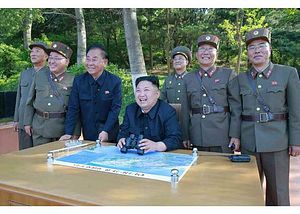Over at ArmsControlWonk, Dave Schmerler has an interesting post looking at what North Korea has done at its inaugural launch sites for the Hwasong-14 and Hwasong-15 intercontinental-range ballistic missiles (ICBMs) — the two systems that gave the country the ability to strike the contiguous United States for the first time.
It turns out, based on satellite imagery, that the North Koreans have started building monuments at both sites to memorialize an immensely strategically significant technological accomplishment — the realization of a 50-year dream effectively, since current leader Kim Jong-un’s grandfather saw a role for nuclear weapons in the country’s national defense strategy.
For Kim, nuclear weapons are half of the so-called byungjin line — his signature promise to bring North Korea a secure nuclear deterrent and economic prosperity simultaneously. The Hwasong-15’s successful flight-test in November 2017 sealed in the nuclear half of byungjin, freeing Kim to focus on the second. (This could be one of the motivators behind the latest round of inter-Korean rapprochement, initiated by North Korea in early 2018.)
That North Korea would build monuments to its ICBMs isn’t necessarily surprising, even though it’s striking that they’d choose to do so at the sites where these missiles were first launched. As Schmerler observes in his post, North Korea has done everything from stage multiple over-the-top celebratory concerts for the scientists and missileers who participated in the launches, mass rallies, and even issued stamps (with telemetry data!) to celebrate these accomplishments. A monument is hardly a step too far.
For what it’s worth, the North Koreans aren’t anthropological curiosities for choosing to build monuments in honor of their nuclear program. To this day, the United States has a standing monument at the Trinity Test Site in New Mexico to immortalize the first nuclear explosion on earth, on July 16, 1945.
And just as harnessing the power of the atom revolutionized the way in which the United States would wage total war on Japan in the final weeks of the Pacific War, North Korea sees equal significance in its ICBM accomplishments.
All this brings me to the concluding point and the fundamental observation from all this that may be most relevant today. You’ll often — though less these days — hear the point that the reason North Korea pursued its nuclear weapons was so that it would have an immensely high-value bargaining chip to use in future talks with the United States. If that were true, there’d presumably be less of a propaganda push around these weapons; Kim wouldn’t want to be seen giving them up by his own people.
Of course, that observation has always been unsupported — especially in recent years, as North Korea has fleshed out something of a coherent nuclear strategy. We’re currently in the early stages of a summit between U.S. President Donald Trump and Kim potentially shaping up. If Trump does meet Kim, he’d do well to take note of the strategic and symbolic significance these weapons have for the North Korean regime.

































